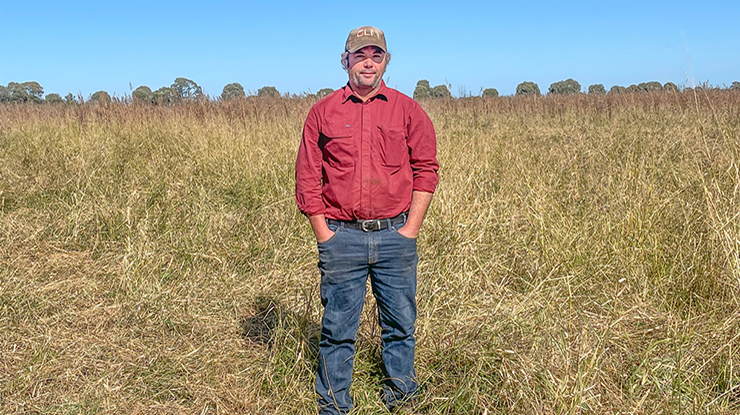Fertilising pastures boosts production
02 March 2023

A group of northern producers looking to improve property productivity used a Meat & Livestock Australia (MLA) Producer Demonstration Site (PDS) to see if it’s economical to fertilise sown pastures – the results show it can be, with the right steps.
Included in the project was Queensland beef producer Sam Haig (pictured) who has reaped the benefits of fertilising his pastures – including doubling carrying capacity – as a result of participating in an MLA PDS.
The PDS also gave him the confidence to make changes to his ongoing pasture management strategies.
Sam and his wife Kate both work off-farm, so they became involved in the PDS as they were looking for ways to boost production in their cattle trading enterprise without buying more land.
“We just weren’t growing enough feed for ground cover, and we were also getting a lot of soil erosion,” Sam said.
“During 2018 and 2019 it was pretty dry with only erratic rainfall and the country became really rundown and we were spending a lot of money on buying in feed.
“Feeding your stock all the time takes an emotional toll too.”
Previously, Sam would plant a forage crop to give the pasture a spell, but because of the dry season it was hit and miss as to whether he would get it planted at the right time.
“We’d spend a lot of money on fertiliser and maintaining the forage crop, but we weren’t seeing the return on investment,” he said.
Increased ground cover
While the production gains from the PDS fertiliser trial – including average weight gains of 130kg per adult equivalent/year – were pleasing, Sam was also impressed to see ground cover and water retention improve.
“We used to have to get three or four falls of rain to get a good growth response, but now every fall above 10mm we see the pasture respond.
“The pasture seems a lot more resilient and during cold periods it’s still green.
“This pasture improvement has allowed us to almost double our carrying capacity.”
The paddock where Sam hosted the PDS was light red loam soil which had been historically cropped.
Despite man-made contours, water would run straight through – something Sam no longer sees.
“I’ve been here 20 years and I haven’t seen it in this good of a condition – we’re not losing anything with run-off.”
Soil testing essential
One of Sam’s key takeaways from the PDS was the importance of soil testing.
“The key was to get soil testing done to know what nutrients we need to add,” Sam said.
“There’s no point fertilising a paddock by just throwing everything at it, you need to know what specific nutrient is missing and address that.”
Sam now plans on soil testing every few years to identify imbalances which are visually apparent.
He’s also going to focus more on pasture quality – another outcome of the PDS.
“I now let the pasture recover for a longer period so it’s more resilient. I move my cattle more often to utilise the best quality feed.”
Building confidence
Sam found participating in the PDS very rewarding as he watched paddocks which once only had ankle-high ground cover now grow ground cover “so high you can barely walk through it”.
“Every time you get a result like that it builds your confidence,” he said.
“Before we did the PDS there was limited information on fertilising pasture for northern producers, so after seeing the results it has really boosted my confidence.”
|
LESSONS LEARNT
|


